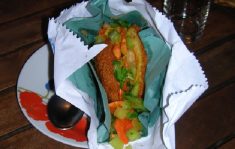| | A: | Andreia, qual você diria que é a especialidade gastronômica que mais representa a culinária baiana?
Andreia, what would you say is the gastronomic specialty that most represents Bahian cooking? |
| |
B: | Rapaz, essa é fácil, tá na cara, é o acarajé. Veja só, massa de feijão-fradinho, cebola, sal, frito em azeite-de-dendê, e ainda servido com pimenta, vinagrete, camarão e vatapá. É o típico da cozinha afro-baiana.
Man, that’s easy, it’s as plain as your face, it’s acaraje. Just look, black-eyed beans dough, onions, salt, fried in palm oil, and served with peppers, vinaigrette, shrimp and vatapa. It’s a typical afro-bahian food. |
| |
A: | Você acha que é mais típico do que, por exemplo, o caruru? O caruru que é feito com quiabo, camarões secos moídos e azeite de dendê é super típico também, Andreia.
Do you think it is more typical than, for example, caruru? Caruru is made from okra, dried ground shrimp, palm oil, and it’s super typical too Andreia. |
| |
B: | É, mas no caso do acarajé, Antônio, tem toda aquela imagem das baianas com vestimenta africana, vendendo nas ruas. Na minha opinião acho que o acarajé ganha, viu?
Right, but in the case of acaraje Antonio, it has that whole image of bahians with their African clothing, selling on the street. In my opinion, I think that acaraja wins. |
| |
A: | Sei lá, eu nem sei direito, que que é esse o feijão-fradinho. É típico na culinária baiana?
I don’t know, I don’t even really know what this black-eyed beans is. Is it typical of bahian food? |
| |
B: | Olha, é um feijão que se usa muito no nordeste, rapaz. A gente quebra ele num moinho, em pedaços grandes, aí deixa de molho lá na água para tirar a casca. Depois, você passa novamente no moinho para criar uma massa bem fina. É muito trabalho, viu?
Look, it is a bean that is used a lot in the northeast, man. People break it up in a grinder, in big pieces, and then they let it soak in water to remove the shell. Then you grind it again to make a thin dough. It’s a lot of work, you know? |
| |
A: | Sei, e vem cá, você acha que o sabor vem mais da massa ou mais do azeite-de-dendê que se usa?
Got it, and tell me, do you the think the flavor comes more from the dough or more from the palm oil that you use? |
| |
B: | É uma boa pergunta. O segredo para o acarajé ficar macio está no tempo que a gente bate a massa. Ela tem que ficar com a aparência quase de espuma. Mas eu concordo com você, o azeite-de-dendê tem um sabor muito característico e ele é indispensável, viu?
That’s a good question. The secret to acaraje to be soft is in how long you beat the dough. It has to have a foamy consistency. But I agree with you, palm oil has a very characteristic flavor and it is indispensible, you know? |
| |
A: | Pois é, e quando eu vejo as baianas preparando o acarajé, parece que o azeite está bem quente.
Yea, when I see the Baianas preparing the acaraje, it seems like the oil is really hot. |
| |
B: | Isso mesmo, bem quente. E você já viu como elas usam as duas colheres para fritar, uma para pegar a massa e a outra para moldar os bolinhos. Olha, realmente é uma arte.
It really is, really hot. And you saw how they use the two spoons to fry it, one to get the dough and the other to shape the little balls. You know, it’s a real art. |
| |
A: | É parece que a arte e o segredo está mesmo no jeito que elas cortam o acarajé no meio e botam o recheado com camarão, vatapá, caruru, e pimenta.
And it seems that the art and the secret is in the way that they cut the acaraje in half and put in the fillings with shrimp, vatapa, caruru, and peppers. |
| |
B: | Tá vendo, te peguei. Você também acha que é a especialidade que mais representa a Bahia, não é?
You see, I got you. You also think that it’s the specialty that most represents Bahia, right? |




thank you so much. i listen to your lessons everyday!